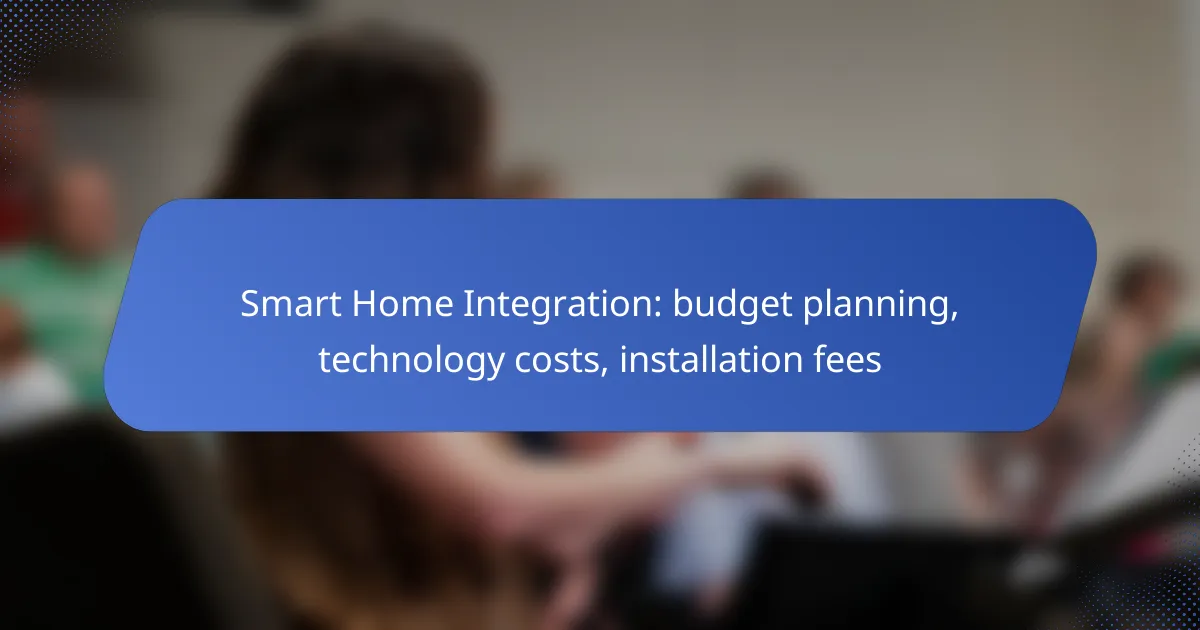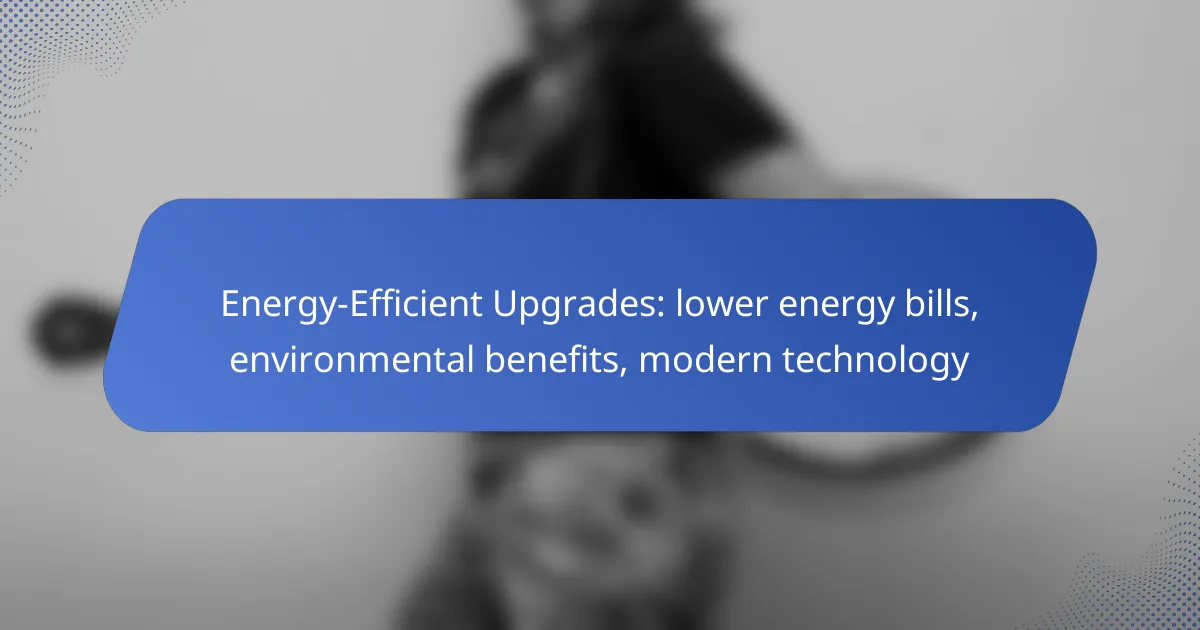Integrating smart home technology requires careful budget planning to account for device costs, installation fees, and ongoing expenses. Understanding the price range for various devices and the complexity of installation will help you create a realistic financial plan that aligns with your goals. By considering both upfront and long-term costs, you can effectively navigate the smart home landscape and make informed decisions.
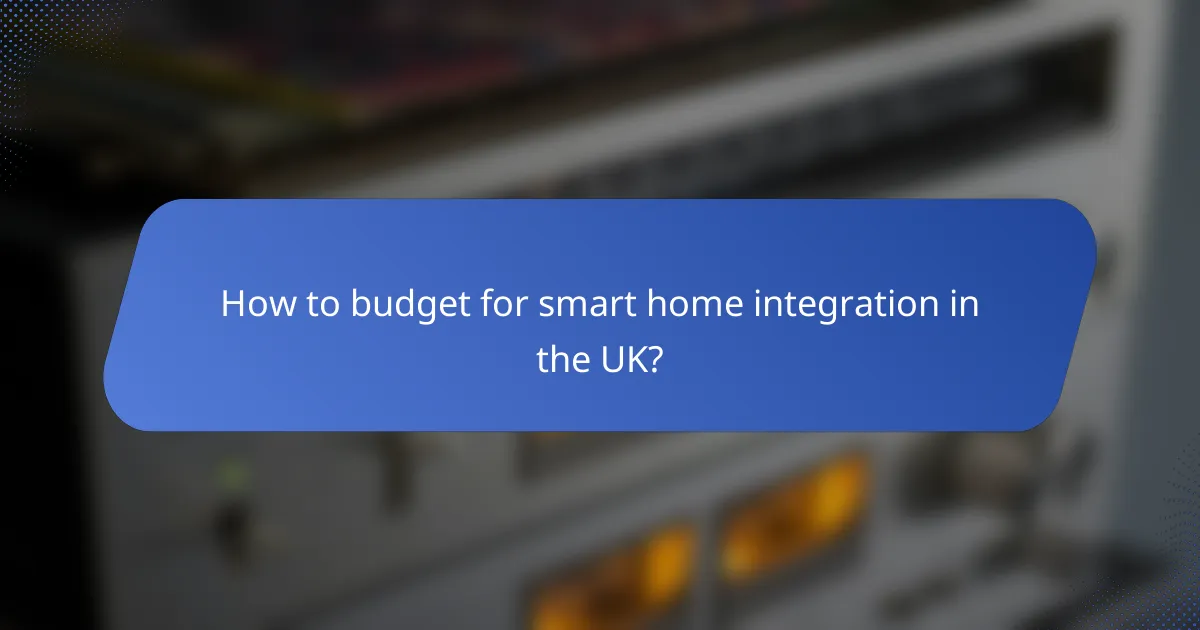
How to budget for smart home integration in the UK?
Budgeting for smart home integration in the UK involves understanding the costs of technology, installation, and ongoing expenses. By planning ahead and identifying key components, you can create a realistic budget that meets your needs.
Identify key components
Start by determining which smart home devices you want to integrate. Common components include smart lighting, thermostats, security cameras, and voice assistants. Each device has different functionalities and price points, so prioritize based on your lifestyle and needs.
Consider compatibility between devices and platforms, as some systems work better together than others. For example, devices that support Zigbee or Z-Wave protocols may offer better integration options than those that operate on proprietary systems.
Estimate total costs
To estimate total costs, research the prices of the devices you plan to purchase. Smart home devices can range from around £20 for basic smart plugs to several hundred pounds for advanced security systems or smart appliances. Factor in installation fees, which can vary based on complexity and whether you hire a professional.
As a rough guide, budget anywhere from £500 to £2,000 for a basic setup, depending on the number and type of devices. Always check for any available discounts or package deals that can help reduce overall costs.
Consider ongoing expenses
Ongoing expenses for smart home integration may include subscription services for cloud storage, premium features, or maintenance. For example, some security systems require monthly fees for monitoring services, which can range from £10 to £30 per month.
Additionally, consider the potential increase in energy bills due to the use of smart devices. While many smart technologies can help reduce energy consumption, it’s wise to monitor usage to avoid unexpected costs. Regularly review your subscriptions and services to ensure they align with your needs and budget.
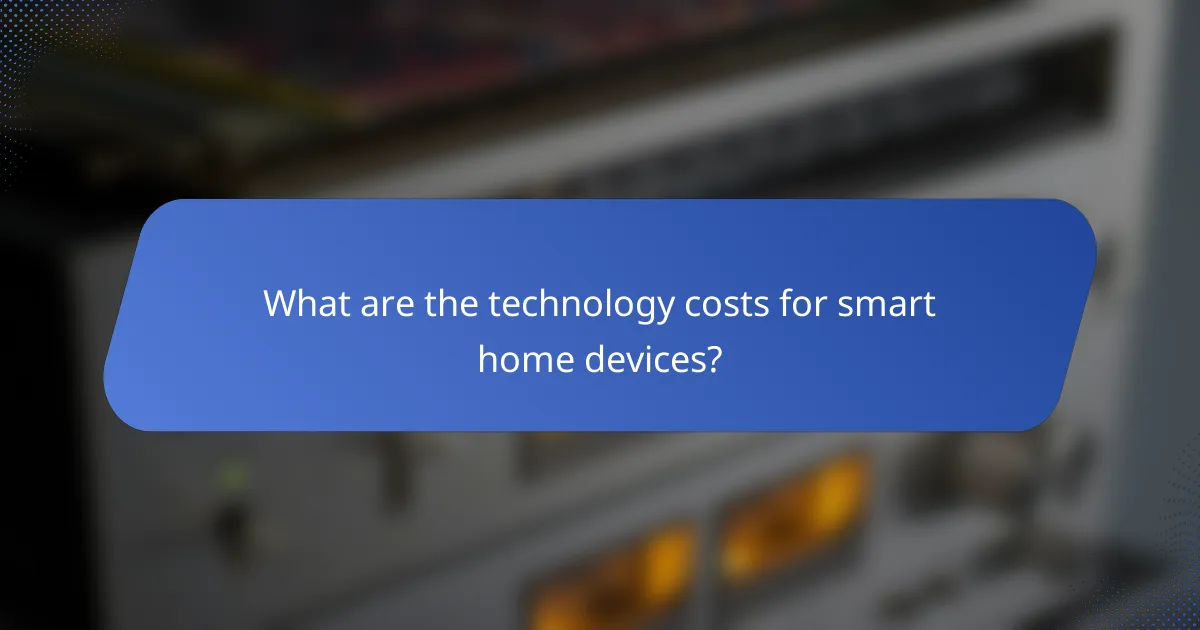
What are the technology costs for smart home devices?
The technology costs for smart home devices can vary significantly based on the type of device and its features. Generally, you can expect to invest anywhere from a few dozen to several hundred dollars for individual devices, with additional costs for installation and integration.
Average costs of smart speakers
Smart speakers typically range from around $30 to $300, depending on the brand and features. Basic models, like the Amazon Echo Dot or Google Nest Mini, are usually priced at the lower end, while premium options with enhanced audio quality and additional functionalities can reach higher price points.
When budgeting for smart speakers, consider whether you want a standalone device or one that integrates with other smart home systems. Some models may offer better compatibility with specific ecosystems, which can influence your overall smart home setup costs.
Price range for smart thermostats
Smart thermostats generally cost between $100 and $300. Basic models provide essential features like remote control and scheduling, while advanced models may include learning capabilities and energy usage reports.
Installation costs can add another $100 to $200 if you hire a professional. However, many smart thermostats are designed for DIY installation, which can save you money if you’re comfortable with basic home improvement tasks.
Costs of smart security systems
The costs for smart security systems can vary widely, starting from around $200 for basic packages to over $1,000 for comprehensive setups. Basic systems often include a few cameras and sensors, while more extensive systems may feature multiple cameras, smart locks, and professional monitoring services.
When planning your budget, consider ongoing costs such as subscription fees for monitoring services, which can range from $10 to $50 per month. Additionally, some systems may require professional installation, which can further increase your initial investment.
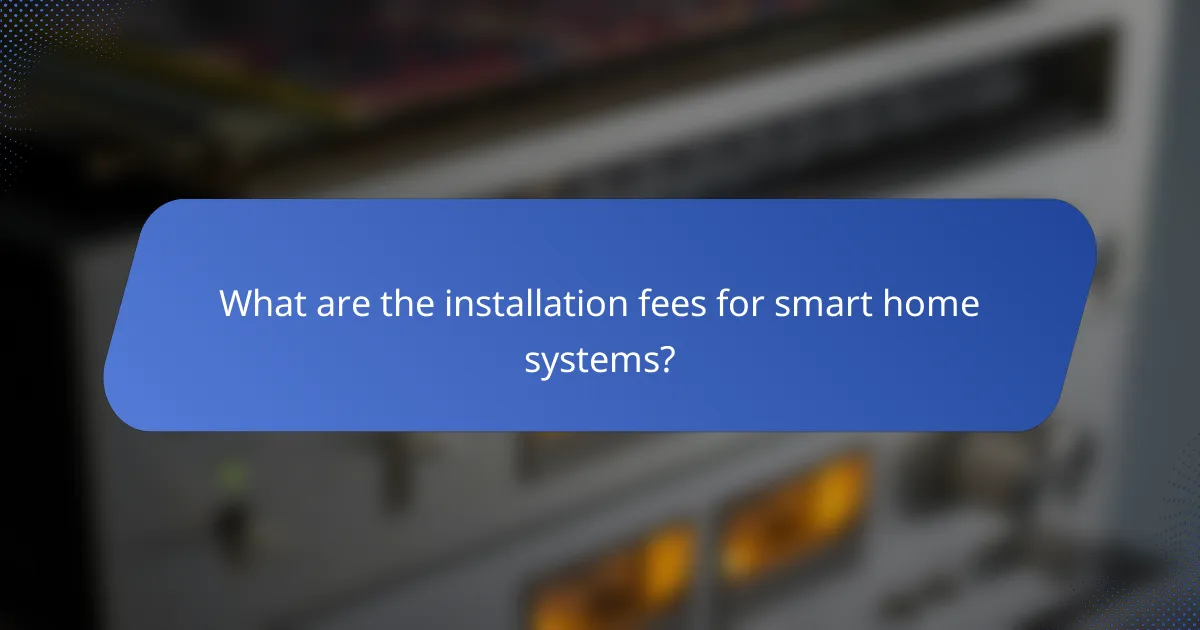
What are the installation fees for smart home systems?
Installation fees for smart home systems can vary significantly based on the complexity of the setup and whether you choose professional help or opt for a DIY approach. Generally, you can expect to pay anywhere from a few hundred to several thousand dollars depending on your specific needs and choices.
Professional installation costs
Hiring a professional for smart home system installation typically ranges from $100 to $200 per hour, with total costs often falling between $500 and $2,500. This price can increase if your system requires extensive wiring, multiple devices, or specialized expertise. Always request a detailed quote to understand what is included in the service.
Some companies offer package deals that cover installation and equipment, which can be more economical. Be sure to compare these options to find the best value for your budget.
DIY installation savings
Choosing to install a smart home system yourself can save you a significant amount of money, often reducing costs to just the price of the equipment. Many smart devices are designed for easy installation, with user-friendly guides and online tutorials available to assist you.
However, be cautious of potential pitfalls. Improper installation can lead to system malfunctions or security vulnerabilities, so ensure you have a good understanding of the setup process before proceeding.
Factors affecting installation fees
Several factors can influence the installation fees for smart home systems, including the type of devices being installed, the complexity of the home layout, and the need for additional wiring or network upgrades. For instance, installing a comprehensive security system may require more labor and materials than setting up a few smart lights.
Additionally, geographical location can play a role in costs, as labor rates and availability of skilled technicians vary by region. Always consider these factors when budgeting for your smart home installation.

What financing options are available for smart home integration?
Several financing options can help you manage the costs of smart home integration, including home improvement loans, credit card financing, and manufacturer financing programs. Each option has its own benefits and considerations, making it essential to evaluate which best suits your financial situation and project needs.
Home improvement loans
Home improvement loans are specifically designed for renovations and upgrades, including smart home installations. These loans typically offer fixed interest rates and longer repayment terms, making them a manageable option for larger projects.
When considering a home improvement loan, check if your lender requires collateral, such as your home equity. Interest rates can vary, so shop around to find competitive offers that fit your budget.
Credit card financing
Credit card financing is a flexible option for smaller smart home projects, allowing you to pay for items as you go. Many credit cards offer introductory 0% APR periods, which can help you avoid interest if you pay off the balance within that timeframe.
However, be cautious of high-interest rates that can apply after the promotional period. It’s advisable to keep your credit utilization low and avoid overspending to maintain a healthy credit score.
Manufacturer financing programs
Many smart home device manufacturers offer financing programs to make their products more accessible. These programs often include promotional rates or deferred payment options, allowing you to purchase devices without immediate financial strain.
Before committing, review the terms carefully, as some programs may have hidden fees or high-interest rates after promotional periods. Always compare these offers with other financing options to ensure you are getting the best deal for your smart home integration project.

What are the prerequisites for smart home integration?
Smart home integration requires a solid understanding of your home’s infrastructure, device compatibility, and internet capabilities. These prerequisites ensure that your smart devices work seamlessly together and provide the desired functionality.
Assessing home infrastructure
Evaluating your home’s infrastructure is crucial for successful smart home integration. Check the existing wiring, electrical systems, and layout to determine if they can support smart devices. For instance, older homes may need upgrades to accommodate smart lighting or security systems.
Consider the placement of devices as well. Devices like smart speakers or cameras should be positioned for optimal connectivity and coverage. A simple floor plan can help visualize where devices will be installed.
Understanding compatibility
Compatibility among devices is essential for a cohesive smart home experience. Ensure that the devices you choose can communicate with each other, often facilitated by a central hub or platform. Popular ecosystems include Google Home, Amazon Alexa, and Apple HomeKit.
Check for compatibility with protocols such as Zigbee, Z-Wave, or Wi-Fi. Some devices may only work within specific ecosystems, which can limit your options. Always verify product specifications before purchasing.
Evaluating internet requirements
A reliable internet connection is vital for smart home integration. Most smart devices require a stable Wi-Fi network to function properly. Aim for a broadband connection with speeds of at least 25 Mbps for smooth operation, especially if multiple devices are in use simultaneously.
Consider the placement of your router and any potential dead zones in your home. Using Wi-Fi extenders or mesh networks can help improve coverage. Additionally, ensure your router’s firmware is up-to-date to maintain security and performance.
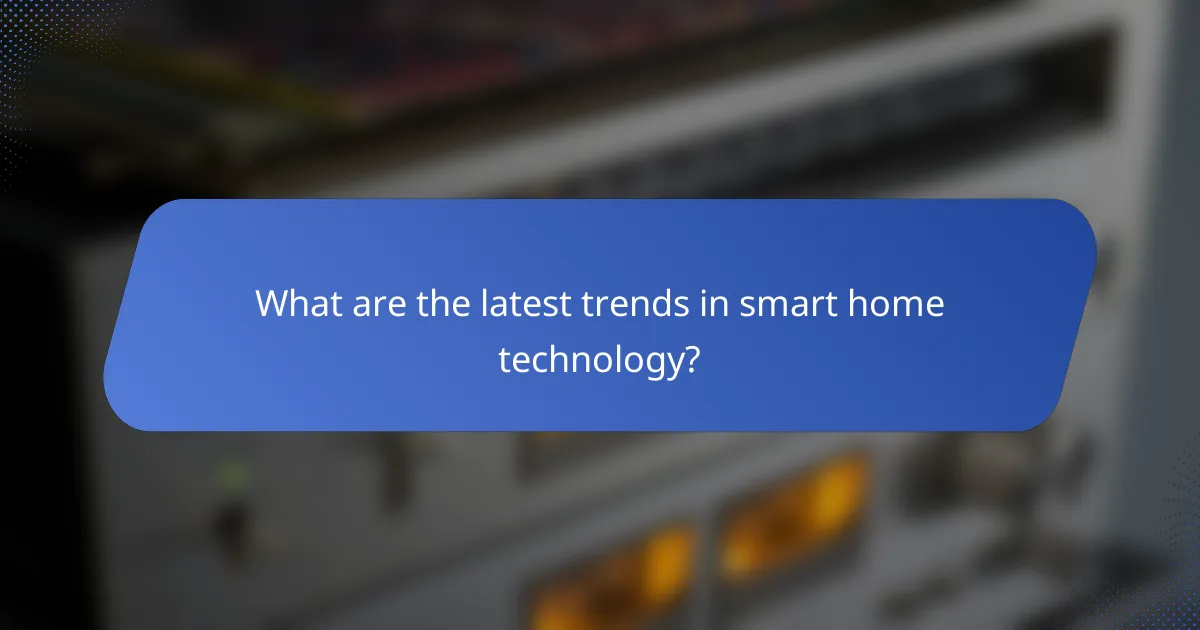
What are the latest trends in smart home technology?
The latest trends in smart home technology focus on increased automation, enhanced security features, and seamless integration with various devices. Homeowners are increasingly adopting smart systems that improve energy efficiency and provide remote access to home management.
Integration with AI assistants
Integration with AI assistants like Amazon Alexa, Google Assistant, and Apple Siri is a key trend in smart home technology. These assistants allow users to control various smart devices through voice commands, making home management more convenient and intuitive.
When integrating AI assistants, consider compatibility with existing devices and ecosystems. Most smart devices are designed to work with one or more AI platforms, so ensure your chosen assistant can control all your devices effectively. For example, smart lights, thermostats, and security cameras often have dedicated skills or integrations for popular AI assistants.
To maximize the benefits of AI integration, set up routines that automate multiple tasks at once. For instance, a “Good Night” routine could turn off lights, lock doors, and adjust the thermostat with a single command. Be mindful of privacy settings and regularly review permissions granted to your AI assistant to maintain security.






